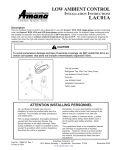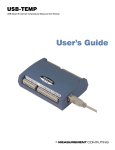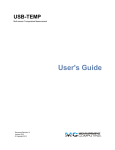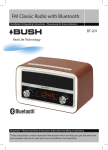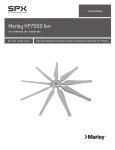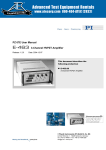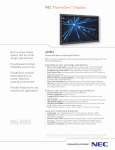Download Amana RCB Instruction manual
Transcript
Available at Surplus Sales LAC02A ® Low Ambient Control Installation Instructions Table of Contents ATTENTION INSTALLING PERSONNEL ............. 1 Description ............................................................ 2 Bill of Material ....................................................... 2 Installation ............................................................. 2 Units Without A High Pressure Control ............................ 2 Units With A High Pressure Control ................................ 3 Wiring ..................................................................... 3 Servicer’s Note ...................................................... 4 Low Ambient Control LAC02A ! RECOGNIZE THIS SYMBOL AS A SAFETY PRECAUTION. ATTENTION INSTALLING PERSONNEL As a professional installer you have an obligation to know the product better than the customer. This includes all safety precautions and related items. Remember, it is your responsibility to install the product safely and to know it well enough to be able to instruct a customer in its safe use. Prior to actual installation, thoroughly familiarize yourself with this Instruction Manual. Pay special attention to all safety warnings. Often during installation or repair it is possible to place yourself in a position which is more hazardous than when the unit is in operation. Safety is a matter of common sense...a matter of thinking before acting. Most dealers have a list of specific good safety practices...follow them. August 1999 The precautions listed in this Installation Manual should not supersede existing practices but should be considered as supplemental information. Amana Fayetteville, TN 37334 10664125 Description 2. Remove and save the control box cover. This kit is for use with any Amana RCC, RCB, RCE, or three-phase RCA/RCB and RCC remote cooling unit which is installed with an indoor coil that includes a thermal expansion valve. The Low Ambient Control kit stops the outdoor fan on your unit when the high-side pressure becomes too low. When the high-side pressure rises, the outdoor fan will restart. This kit can only be used with 208-230 volt units. Currently, remote cooling units are only suitable for operation at outdoor temperatures of 50°F and above. The Low Ambient Control kit allows these units to operate at outdoor ambients as low as 35°F. 3. Remove and save the screws holding the control box in place. Carefully swing the control box about 90° counterclockwise. IMPORTANT NOTE: If cooling operation at outdoor ambients below 35°F, do not use this kit. Contact your Amana distributor or branch office for assistance. 7. Before running the unit, perform a preliminary leak check on the low ambient control. If a leak is found tighten the connection slightly and retest. IMPORTANT NOTE: Do not install this kit in a system with an indoor coil and no thermal expansion valve. Compressor damage could occur which would result in voiding of your warranty. 8. Route the blue wires from the low ambient control into the unit control box. To avoid equipment damage, route the wires so they avoid the fan. Bill of Material (1) (1) (1) (1) (1) (2) (1) Refrigerant Tee,With Two Valve Cores Low Ambient Cutout Control Wire Nut Low Ambient Label Installation Instructions Teflon Seals Extension Tube This kit should only be installed by a qualified, experienced technician. Installation WARNING To avoid the risk of electrical shock, injury, or death, disconnect the electrical power before installing this kit. 4. Remove and discard the cap from the discharge line access fitting. 5. Place a teflon seal in the fitting of the low ambient control. 6. Install the low ambient control on the discharge line access fitting. Tighten to 115 to 120 inch-pounds to avoid refrigerant leaks. Use a backup wrench to prevent damage to the fitting. 9. Carefully swing the control box clockwise to its original position. Reattach it, using the screws removed earlier. Units Without A Discharge Tube Port 1. On RCB**B2A units, remove the screws holding the service valve panel, control box cover, and control box. 2. Swing out the control box, lift the service valve panel up and out. 3. Remove and save the cap from the liquid line valve schrader fitting. NOTE: It is not necessary to remove the schrader core for a low ambient kit. 4. Prepare a connector tee in the kit by removing the schrader core in the tee leg only. Connect the extension tube in the kit to the tee connector where the schrader core was removed. See Figure1 for the tube and tee orientation. Do not connect the tee to the liquid service valve until after the next step. 5. Place a teflon seal in the pressure switch fitting. Install the pressure switch to the end of the extension tube. 6. Locate the extension tube through the slot under the liquid tube in the valve panel. WARNING To avoid possible injury from refrigerant, wear gloves and goggles while installing this kit. 7. Tighten the swivel nut on the tee on to the liquid valve schrader port. CAUTION See the outdoor unit Installation Instructions for other “Safe Refrigerant Handling” guidelines. Refrigerant pressure is present during connection. Take all necessary safety precautions when installing this kit. Units Without A High Pressure Control 1. Remove and save the screws holding the control box cover in place. 8. Attach the schrader cap on the end of the tee. 9. Insert the blue switch wires through the bushing in the back of the control box. 2 10. Carefully replace the service valve panel and screws. Carefully swing the control box clockwise to it’s original position. Reattach it using the screws removed earlier. Units With A High Pressure Control 1. Remove and save the screws holding the control box cover in place. Wiring 1. Disconnect the Violet-20 fan motor lead (not the compressor lead) from the contactor: terminal T2 on single-phase units, terminal T1 on three-phase units. 2. Remove and save the control box cover. 2. The low ambient control includes a blue wire with a straight female terminal. Install this wire on the contactor: terminal T2 on single-phase units, terminal T1 on three phase units. 3. Remove and save the three screws holding the control box in place. Carefully swing the control box about 90° counterclockwise. 3. Locate the Violet-20 fan motor lead from step 1. Cut off the terminal, and strip the insulation off the last 1/2 inch of the wire. 4. Using two wrenches to prevent the line from twisting, remove the high pressure cutout from the high side fitting. (The high pressure cutout has blue wires.) Do not remove any wires from the high pressure cutout. 4. The low ambient control includes a blue wire with a stripped end. Use the wire nut provided to attach this wire to the Violet-20 wire from step 3. For an adequate connection, pliers must be used to crimp the wire nut onto the wires. 5. Place a teflon seal in the female opening of the refrigerant tee. Install the refrigerant tee on the high side access fitting. Using a backup wrench, tighten to 115 to 120 inch-pounds to avoid refrigerant leaks. 6. Reinstall the high pressure cutout on one end of the tee. Tighten to 115 to120 inch-pounds to avoid refrigerant leaks. 7. Place a teflon seal in the fitting of the low ambient control. Install the low ambient control on the remaining end of the tee. Tighten to 115 to 120 inchpounds to avoid refrigerant leaks. 8. Without running the unit, perform a preliminary leak check on the tee, low ambient control, and the high pressure cutout. If a leak is found, tighten the joint slightly and recheck. 5. Using the low ambient label 10767901 as a guide, inspect all wiring carefully. Confirm that all connections are tight and that no errors have been made. Low Ambient Kit Installed In This Unit OUTDOOR FAN MOTOR MOTOR LEADS CONNECTOR VIOLET-20 (IF PRESENT) WIRE NUT LOW AMBIENT CONTROL EXTENSION TUBE VAPOR LINE SERVICE VALVE T2 T1 L2 L1 CONTACTOR Single Phase Unit Shown Figure 2 6. Remove the backing from the low ambient label. Without covering the unit wiring diagram, attach the low ambient label on the inside of the control box cover. Service Valve with Extension Tube, Tee and Cut-Out Figure 1 9. Route the blue wires from the low ambient control into the unit’s control box. To avoid equipment damage, route the wires so they avoid the fan. 10. Carefully swing the control box clockwise to its original position. Reattach it, using the screws removed earlier. 3 7. Replace the control box cover. 8. When the system installation is complete, and the outdoor temperature is 35°F or higher, run the system to confirm proper operation: At compressor startup, the outdoor fan will not initially run. The outdoor fan will come on when the head pressure rises to about 220 psi. During warm weather, the outdoor fan will continue to run as long as the compressor runs. During cool weather, the head pressure will drop after the outdoor fan comes on. If the head pressure drops to about 100 psi, the outdoor fan will shut off. The head pressure will then begin to rise. The outdoor fan will restart when the head pressure rises to about 220 psi. If any sparking, unusual odors, or unusual sounds are noticed, immediately disconnect the electrical power and check wiring and electrical components. With the compressor running, it may be advisable to perform a final leak check on the low ambient cutout and nearby components. Before doing this, read the “Servicer’s Note” section that follows. Servicer’s Note CAUTION Avoid servicing the low ambient control while the unit is operating. The rotating fan blades could cause serious injury. If measurement of the high side pressure is required, use the liquid line valve on the outside of the unit. Also note that most electrical measurements for the compressor can be performed adequately near the contactor, rather than at the compressor itself. If you must service the area near the compressor or low ambient control with the unit in operation, consider doing the following: • Disconnect the electrical power • Unplug the outdoor fan motor. • Carefully reconnect the electrical power. • Operate the compressor only long enough to complete the needed service function. NOTE: Running the system without outdoor airflow will cause the head pressure to be substantially higher than normal. Suction pressure and amp draw will also be higher than normal. Subcooling, however, will be less than normal. 4




